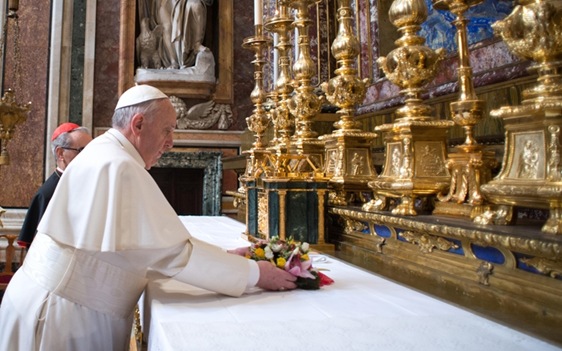That Pope Francis has a strong Marian devotion became immediately clear after his election. In his first speech as Pope he committed himself and the world to Mary. The following day his first visit outside of the Vatican walls was to the basilica of St Mary Major where he prayed to Mary. In his homilies he has at times disseminated his Marian piety. Now that the liturgical Marian month (May) has begun, the Pope has further expressed his devotion. On May 3rd he lead the rosary in the same Marian basilica he visited after being elected and gave a public speech to the people that had gathered there.
Mary, Salus Populi Romani
This particular basilica is known for hosting and displaying the icon of Mary who is called Salus Populi Romani (i.e. salvation of the Roman people). This is a Marian title that underlines her being the protector of the Roman people. In front of the icon, Pope Francis commented: “We are all here in front of Mary; we prayed for her motherly guidance; we took her our joys and sorrows, our hopes and difficulties; we invoked her with the title Salus Populi Romani to ask for ourselves, for Rome and for the world the gift of health. Yes, she gives health, she is our health”.
In expounding his teaching, Francis went on to talk about three ways in which Mary is our health: She helps us grow as men and women, just as a mother cares for her children; She helps us face our difficulties, just as a mother walks with her children; Lastly she helps us make right decisions in life, just as a mother wants her children to live responsibly.
Outside of Roman Catholic piety, it is difficult to understand such a profound “motherly” language of devotion to Mary and to square it with a Christ-centered and a Bible-based faith which unequivocally points to Jesus Christ as the only Mediator between God and man. Biblically, these roles relate to the Christological offices of Jesus as Priest and King. Yet Roman Catholicism attributes them to Mary as an extension of Christ’s role as mediator. Out of its synergism the Roman Catholic faith allows, indeed demands, such a veneration of Mary which has theological, spiritual, and emotional dimensions. Mary is seen as the protector of life.
Papal Marianisms
In closing his speech, Pope Francis addressed the crowd by saying: “Thank you for your presence here in the house of the mother of Rome, our Mother. Hurrah to the Salus Populi Romani. Hurrah to Madonna. She is our Mother. Let us entrust ourselves to her because she cares for us like a good mother”. This time the devotional language matched that of sports enthusiasts: Hurrah, hurrah! The magnitude of Mary’s motherly role stirred the heart and soul of many people gathered there.
Pope Francis has stressed the fact that he wants to emphasize his role as bishop of Rome and has begun to give this emphasis a distinct Marian flavor. We can now begin to see the trajectory of this present pontificate as far as his Marianism is concerned. The last pope to share such a high view of Mary was John Paul II. His motto was “totus tuus” (i.e. totally yours), and his veneration of Marian icons and his practice of Marian devotions were very evident. Benedict XVI has been portrayed as a less Marian Pope, although he has always prayed to Mary on a daily basis and has included many Marian elements in all his work. After a short recess, Mary is once again a prominent figure with Pope Francis. His pontificate seems to be significantly shaped by Marian theology and veneration.
Leonardo De Chirico
leonardo.dechirico@ifeditalia.org
Rome, 10th May 2013





